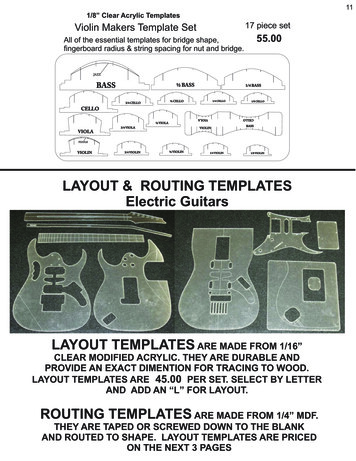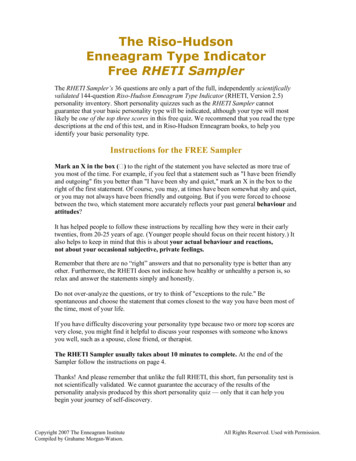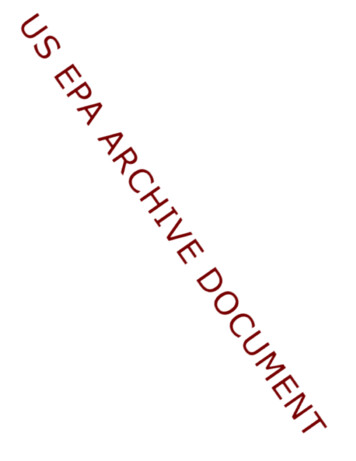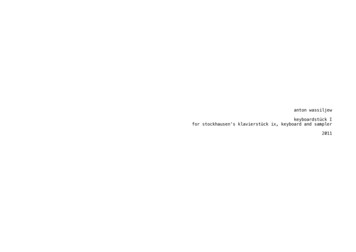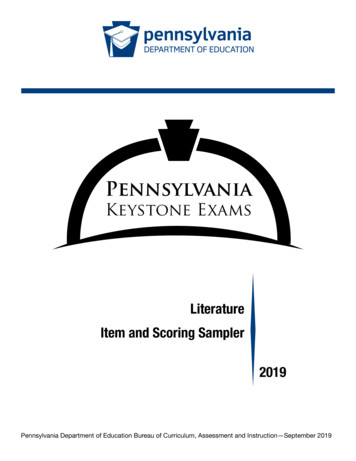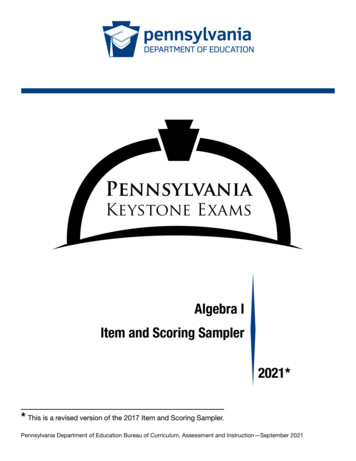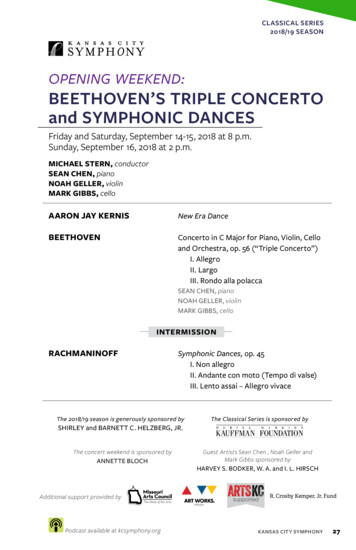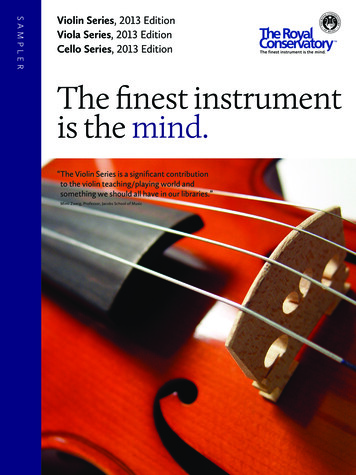
Transcription
SAMPLERViolin Series, 2013 EditionViola Series, 2013 EditionCello Series, 2013 EditionThe finest instrumentis the mind.“ The Violin Series is a significant contributionto the violin teaching/playing world andsomething we should all have in our libraries.”Mimi Zweig, Professor, Jacobs School of Music
Violin Series, 2013 EditionNINE volumes of repertoire each featuring:Violin Repertoire 3A CD of piano accompanimentsContentsA range of erasList A: Repertoire in Baroque and Classical StylesScoreViolin/PianoPartBookPianoCDConcertino in G Major, op. 11First MovementFerdinand Küchler42121Sonatina, op. 163, no. 4Second MovementAnton Diabelli,arr. Kathleen Wood95222Musette in D Major, BWV Anh. 126attr. Johann Sebastian Bach,arr. Kathleen Wood126323Sonatina in F Major, TWV 41:F1Third Movement: PrestoGeorg Philipp Telemann,arr. Kathleen Wood147424Minuetto and Trio in D MajorJohann Georg Albrechtsberger,arr. Paul Jenkins168525List B: Traditional and Romantic RepertoireMinor ModeFrank Blachford1910626Nocturne (In the Second Position)Jean-Delphin Alard2212727Skye Boat SongHighland rowing measure,arr. Hugh J. McLean2413828MazurkaNatalya VladimirovnaBaklanova2614929Wedding Tune, op. 17, no. 24Edvard Grieg,arr. Kathleen Wood28151030Nouvelle agréable! (Good News!)18th-century French carol,arr. Christine Donkin30161131List C: Repertoire Composed After 1930A range of stylesContentsThe Farmers’ MarketChristine Donkin31171232Gabby GhostBruce Chase341813A Sad Waltz (For Missy, Our Kitten)Jean Coulthard36191433Enjoyablepieces for all agesDonkey DoodleWilliam Kroll382015On Holiday, op. 80, no. 15Dmitri Kabalevsky41221635Abracadabrafor Kathy Rapoport36The Clockwork DollDmitri Shostakovich,arr. Konstantin Fortunatov44231737CossacksHugh Colledge andKatherine ColledgeMoto perpetuoHugh Colledge andViolin/Katherine ColledgePiano PianoList A: Concertos, Airs variés,andLullaby,FantasiasWallaby’sop. 5ScorePartBook2GeorgeFialaCD 1 CD2Air varié on a Theme by Rossini,op. 89, no. 2Charles Dancla41The Boy Paganini (Fantasia)Eduard Mollenhauer10622Concertino GrossoFirst MovementThird MovementMilan Kymlicka18103–43–4Concerto in G Major, op. 3, no. 3,RV 310First MovementAntonio Vivaldi,arr. Kathleen Wood2212554646 &Violin4802&œ50œq œpœ24œœœ2627156–76–7Sonata No. 4 in D MinorFirst Movement: AndanteSecond Movement: AllegroJohann Christoph Pepusch,transc. Walter Kolneder37188–98–9& CueList C: Concert RepertoireBerceuseFrank BridgeHornpipeGeorge Coutts18œœœ19œp œœ&œœœ2038œœ2010104623111150241212Catch Me if You Can!Christine Donkin54261313Youngsters’ DanceIstván Szelényi58281414Invocation (Mélodie)Jules Massenet62301515Andantino in the Style of MartiniFritz Kreisler64311616Duo 1Astor Piazzolla,arr. Hywel Davies67321717DaydreamsMurray Adaskin70341818œœfœœœœ39œœœ40œœœœœ �pCueCueBohuslav MartinůFelix Borowskiœ2510 œ& œßPianoSonatinaSecond MovementThird MovementDavid Duke(b. 1950) 58 – 631List B: Sonatas and SonatinasAdoration34œœœ & 1œ #œ œ&œœ #œ œœ 8 œ #œ œ. œ œœœœœ 4Pœœœ woœf1œœpœ & r œr r # œr # œœœƒ gliss.gliss.œ 2#œ3wsimile.In Abracadabra, there are several passages of free alignment of the violin and the piano. e violinist and pianist read from the same score and use cues writteninto the music to coordinate their parts. Downward arrows marked “cue” indicate places the violinist and pianist should make eye contact and signal. A heavyhorizontal line following a note indicates that the violin note is to be held until the piano finishes its sixteenth-note figure. e diminuendo followed by an “s”indicates a diminuendo that ends in silence.Source: e Encore Series for Violin & Piano, book 4 Copyright 1995 e Frederick Harris Music Co., Limited, Toronto, Ontario, Canada.des and Orchestral ExcerptsPLUS! Companion volumes of Technique and Etu
1ContentsIntroduction to Violin Series, 2013 Edition2Violin Repertoire Sample Pages4Violin Technique and Etudes Sample Pages8Violin Orchestral Excerpts Sample Pages and Highlights11Introduction to Viola Series, 2013 Edition13Viola Repertoire Sample Pages15Viola Technique Sample Pages18Viola Etudes Sample Pages19Viola Orchestral Excerpts Sample Pages and Highlights21Introduction to Cello Series, 2013 EditionCello Repertoire Sample Pages2325Cello Technique Sample Pages28Cello Etudes Sample Pages29Cello Orchestral Excerpts Sample Pages and Highlights31Repertoire List33The Royal Conservatory is one of the largest and most respected music education institutionsin the world, providing the definitive standard of excellence in curriculum design, assessment,performance training, teacher certification, and arts-based social programs.The mission of The Royal Conservatory, to develop human potential through leadership inmusic and the arts, is based on the conviction that the arts are humanity’s greatest means toachieve personal growth and social cohesion. The curriculum for the study of music developedby The Conservatory has become Canada’s national standard and its broad use has served tobind together the people of the nation with the thread of shared creative experiences.The over five million alumni of The Royal Conservatory have all enjoyed the many benefitsof music study and carried these benefits into subsequent careers as doctors, engineers,lawyers, business leaders, athletes, and teachers. Others, such as Glenn Gould, Oscar Peterson,Martin Beaver, the St. Lawrence String Quartet, and Measha Brueggergosman have achievedinternational acclaim and defined Canada to the world.The Royal Conservatory is also a leader in the development of arts-based programs designedto address a range of social issues such as youth at risk, the development of children in theirearly years, and wellness in seniors. The Conservatory’s Learning Through the Arts andLiving Through the Arts programs utilize the latest research findings in neuroscience and thesocial sciences to create practical education programs with specific objectives and quantifiableoutcomes.At its national base, the TELUS Centre for Performance and Learning in Toronto, The RoyalConservatory offers an extensive set of training programs for gifted young artists through TheGlenn Gould School and The Phil and Eli Taylor Performance Academy for Young Artists.The Conservatory also presents and produces a wide range of concerts featuring the finestCanadian and international artists in its magnificent performance spaces, Koerner Hall andMazzoleni Hall.Entrenched in the minds and hearts of Canadians, The Royal Conservatory has unitedgenerations of citizens since its inception in 1886.For more information, please visit rcmusic.ca.
2Introduction toViolin Series, 2013 EditionThe Violin Series, 2013 Edition serves as the official material forThe Royal Conservatory examinations.The present Violin Series, launched in 2013, is the fourth edition of this acclaimed series originallypublished in 1992. This new edition builds on the strong foundation of previous editions, and hasbeen updated, refined, and expanded to meet the needs of teachers and students.The Violin Series embraces a progressively levelled, multifaceted approach, systematicallyorganizing material into separate components: Repertoire, Recordings, Technique and Etudes, andOrchestral Excerpts.Guide to Levels and Components for the Violin Series, 2013 Edition:Series LevelViolin RepertoireViolin RepertoireCompact DiscsViolin Technique andEtudesViolin OrchestralExcerptsPreparatory Level Level 1 Level 2 Level 3 Level 4 Level 5 Level 6 Level 7 Level 8 Level 9 Level 10 Level 11 / ARCT Violin RepertoireNine progressive volumes contain repertoire that ispedagogically relevant and appealing to students,reflecting a broad range of musical styles andperiods. Elementary levels include compositions andarrangements by contemporary violin pedagogues, aswell as the works of composers such as Edward Elgar,Leoš Janáček, and Bela Bartók. Intermediate andadvanced volumes include composers presented in thisseries for the first time: Frank Bridge, Antonín Dvořák,Aleksandr Glazunov, Astor Piazzolla, and many others.In order to fully develop their musicianship andtechnique, students are encouraged to work on manypieces at each Level.This varied and balanced repertoire selection willprovide teachers with the flexibility to choosepedagogically sequenced material that supports theirindividual teaching style and method. The repertoirevolumes will inspire and excite students of all ages,helping them develop technical mastery, artisticmaturity, and a lifelong appreciation of music.
Violin Series, 2013 Edition3The pieces in each Violin Repertoire book are divided into lists according to style or stylistic period.LevelList AList BList CPreparatory Level –Level 2Pieces in a slowertempoPieces in a fastertempoLevel 3Music ComposedDuring the Baroqueand Classical PeriodsMusic ComposedMusic ComposedDuring the Romantic After ca 1930Period and TraditionalPiecesLevel 4Concertos, Sonatas,and FantasiasMusic ComposedDuring the BaroquePeriodConcert PiecesLevel 5Concertos, airs variés,and FantasiasSonatas and SuitesConcert PiecesLevel 6 – Level 7Concertos andairs variésSonatas and Sonatinas Concert PiecesLevel 8Concertos andairs variésSonatas and Sonatinas Concert PiecesList DUnaccompaniedWorksViolin Repertoire Compact DiscsRecordings of each piece in the Repertoire volumesinclude performances by some of North America’smost accomplished violinists and pianists, offeringinspiration and a model for performance practice.Additionally, each piece has been recorded with thepiano alone, providing students with opportunities topractice with accompaniment.Violin Technique and EtudesScales and arpeggios are ordered pedagogically, andare closely linked to the technical demands of thecorresponding Level’s repertoire. For instance, athree-octave violin scale is introduced with G majorin Level 5, since Violin Repertoire 5 requires facility upto 5th position. New skills such as double stops, oneoctave major scales in 6ths, harmonic minor scales in3rds and octaves, and two-octave double stop scalesare introduced gradually and build on the foundationestablished in previous levels.Teachers and students will appreciate each volume’sextensive choice of material, from traditional Etudes tomodern Repertoire by leading violin pedagogues. Etudeswere chosen for their technical relevance and musicalmerit, supporting each Level’s keys and hand shapeswhile helping students progressively develop a varietyof skills.Violin Orchestral ExcerptsOrchestral Excerpts contain a variety of selections fromstandard orchestral repertoire. In addition to firstparts and concertmaster solos, these volumes includeexcerpts taken from string orchestra and quartetliterature.Orchestral Excerpts reach beyond assessmentpreparation. Developing performers playing inorchestras will appreciate having a collectionof orchestral repertoire carefully edited withconsideration of their level of technical development.Advanced performers will notice that these singlevolumes for each instrument include a multitude of theexcerpts that appear on many North American auditionlists. Violin Orchestral Excerpts also contains selectionsfrequently encountered in chamber ensemble playing.
4Violin Series, 2013 EditionRepertoire Sample Pages4Harold Birston(b. 1960)Maestoso q 84 – 92Violin# 4& # 4 1#& # 44 gggggggg p? # # 4 gggg4Pianoœœpggggggggggggœœœœœ,wœ#& #,wwwwwww? ## #& # n? # # nn#& #œœfœœœ16U&wœp&?# œDreamily q 92 – 100 &# .œ?#11&&#?#16&&00œœœ##?# n0 .œœ.œœœœœœœ. œœœœ0.œœœ œP œœ œœœœœ œ œœ œœœ œœ œœ cresc. œœœœœœœœœœœ œœœœ œœ œœœœœœœœœœ œœ#œ œ œ œ œ œ œ œ œ œ œ œ œ œ œ œœœœcresc.œ0 œ œ œ œ œ œ œ œœœœœ œœF œ œœ œ œ œ œ œ œ œ œ œ œ œ œ œ œ œœœœ œœœœœœœ 0œ œœ œœ œœœ œœœœœœ œ œœœ œœœœœœœ œœ œ œ œ œ œ œ œ œ #œ œ œ œ œ œ œ œ #œ œ œ œ œ œ œ œ œ œ œ œ œ œ œ œ ff# ‰œœ “toot!”œœœ œœœ œ‰jœ œ œ œœjœ œœœ œ œ - œœ.œœ# .œœœœSlithery q 112 – 120Pianoœœœœœœœœ œœ. .ŒœFpizz.? œ œa tempo œPœŒœœ. œ.Œ ? #œ œpœ œ . œœ *LHŒ œ.Œ œ œ# œ .Œ œ œœ FŒ&œœŒœ 1 .œœ. œœ.P leggieroœ œ. .œœœ. .Œ # œœ œœœ œ. .œœœ #œŒŒœœœ œœœ. .œ # œ .œ-œœœ œœ. .œ œ. Œœœœ œœœ. .œ # œ .Œ œœ Œ œ.œ &FŒœœ.f#œœ #œœ œœ# .# . #œŒœ* Indicates notes that may be played pizzicato with the third or fourth finger of the left hand. Copyright 2011 P. Popp. Reprinted by permission of the composer.Violin Repertoire 1œ# 1 .pPaulette Popp(b. 1948)arr. Christine GaleŒ &œ œœ. œ.P leggieroœœ . œ œ. arco#œF .œœ. œœ. . œŒœp . œœ#œ . œ3 Œ œ œF . .Œ œ œ# . ?Œ œœœ.F a tempo? . .Œ œ œ#œ .Œ& & #œ? œ œ .21 œ& ? 43 Œ œ œ œ.P? 43 .& Œœœ& 43Violin14nœ e Plucky Snake&Œ.œœœ.œœSource: Costume Party: Elementary—Early Intermediate Violin Solos with Piano Accompaniment Copyright 2009 e Frederick Harris Music Co., Limited, Toronto, Ontario, Canada.Violin Repertoire 1œœP7œœœ œœœœ.œ.œœChristine Donkin(b. 1976) 1.œ.œ .œb .œ# œ. œœœœ 14 e Tooth Fairy&6œœ œœ œœ œœœ œœœœœPreparatory Violin Repertoire12PianoœœœSource: e Encore Series for Violin & Piano, book 1 Copyright 1995 e Frederick Harris Music Co., Limited, Toronto, Ontario, Canada.Preparatory Violin Repertoire# œ . œ& 43p# 3 .& 4& œœœ?U LH# 34œ œ œ œ œ œ œ œ œœœœœœœœ œœœœœœœœ œ œ œ œ œ œ œ œPœ4 œ œ œ œ œ œ œ # œ œ œ œ œ œ œ œ œ œ œ œ œ œ œ œ& #œ œ œ œ œ œ œ œF&ggg wwwwggg wwgggg Uggg wwgg w&6& œ œ œ œ œ œ œ œœœSource: Excursions for Violin Copyright 2013 e Frederick Harris Music Co., Limited, Toronto, Ontario, Canada.Violinœœ œœp œ œ? 42 œœ 11nnp? ##Jean Ethridge(b. 1943)02&4?nf13#& #2& 4 œ œ œ œ œ œ œ œpPianoœœ#& # 0non legato#& #9With energy q 80 – 88Violinsimile519 e Subway TrainIn Ancient TimesU poco rit.ŒUŒ?# . Œ œ # œ u f poco rit.U . . .Œ œ œ# .œPœ.Œœœœ. œ.Œ ?# œ œpœ œ .
5Violin Series, 2013 EditionRepertoire Sample Pages24for David Morganop. 22, no. 4Andantino q 69 – 76Violin&œœœ#& 43œ œ œ# œpœ . . œ- .œ#j& œ œ . # œœœ œ œ œj .Jjp? # ‰ œ œ œ œœ Œ Œ . .13&# œ-&œ œ œ-œ-œ-œ-œ œ œœœœœ#œ# .& . œ‰ œ‰ œ œ œ œœœ œœ.œ- œ- œJfœœ . n œ # œœ .œ #œJjfœ œ .œ . . .œ œ œœ œ œ- œrit. e dim.œœ Œœœrit.œœœ-œ-a tempoœ œœp . . . .fjjj œ œ œ? # ‰ œœ œœ œœ ‰ œœ œœ œœ ‰ . œ œ œ . . . . .œ œ œ . . . .π ‰ œ œ œj œj œ œ œj . .a tempoŒŒœ œœœœ œœœj j‰ œœ œœ ‰ œœœ œœœœ- œ-Œ1 U 1.œ- œ- œ- œ- œ- œ- œjœœ .œ œ œ œfp dim. π œœœœœ-œ-U.2.j.jœœ œœ œ œ œπ UŒ .œœ p Allegro con brio q 66 – 721.Piano4&4 œœf ? 4 #œ4 œ œ& @35U œ œ œ@œ œ œ œ œ! ! ! !œ! !& œ! # œ! œ! œ! œ! œ! œ! œ! œ! œ! œ œ !œ !œ !œ !œ04poco a poco cresc.j# œœœ.jœ.& œ.œœ .p? œ.-œœœ-œœœ-Violin Repertoire 2jœ# œœ.? œœ .œœJIII: PrestoPresto h 69 – 76 œ & b c œf1&bc œf? c œbœœ œ œœœ&b8 œp& b&bœ& b&b?bœ œœœœ œ n œ1 œPœœPœŒŒ œ œ œ œœœ0œœœ œ œ œœœœœœœœœœ œ œ 0œŒœœœ-œ-œœ œ œ œ œ œ œœœœ # œœp- subitoœœœ œ œ œ œœ- ! œ! n œ!œpŒœ œœ œ ! œ! œ! œ!! !œ ! ! œP! ! œ! # œ! œœ œƒ# œœœœœœŒœœœŒŒŒœœœœ0Œ #œœŒ œ2ŒŒnœnœ0Cheerfully q 76 – 842ŒœœœŒViolinŒŒPiano& b 42 & b 42 ? b 42pjœ. n œ œ. 5& b œœœœœœ&b œœ jœ ‰œŒŒœ œ 2œœŒœŒœœœ?bœ.9œœ&b œŒŒœŒ œ œ œœ0Œnœn œœœ œ œ œ n œœ œœfœ œœ œ œ œ œ œœœ œ œ0 œ2 œ œ œœ œœŒf0œŒœœFœ œœ œ œ œ œœœ œœœ œ œ œ œ œ œ œœ œ œ œ œ œ œ œœ3 œ œ œF op. 17, no. 24œ œ œ œSource: Sei suonatine per violin e cembaloArrangement copyright 2013 e Frederick Harris Music Co., Limited, Toronto, Ontario, Canada.Violin Repertoire 3œ-Wedding TuneGeorg Philipp Telemann(1681–1767)arr. Kathleen WoodœœœŒœœœ nœ œ œ œ œ œ œœœnœœœŒœœœ1œ œœœœœ œ œ œ1œœ œ œ œ œpœ œ?b12œœ?b#œ œ œ œ.!œ ! ! !fq! indicates two thirty-second notes / q! indicates four thirty-second notesTWV 41:F1& b œœ œ œ-4œœ œ œ œ œœœœ œ œ œ œ œƒœœœ œ #œ œ œœœœœ28Sonatina in F Major4œ # œ œ@Violin Repertoire 214Pianoœ@Source: e Encore Series for Violin & Piano, book 2 Copyright 1995 e Frederick Harris Music Co., Limited, Toronto, Ontario, Canada.Source: Six Very Easy Pieces in the First Position, op. 22Violinœ œ œ œ # œ œ œœœ œœœ- Pœ- œœ œ œ #œ œœœ œœ œ œ œ œ #œ œ œœœ! ! œ # œ œ œ œ& ! !œ !œ !œ œ! œ! œ œ ! ! ! !œ.& œœ .œ. œ # œ œœ #œœ œ œ œ œ& œœœ # œ œ œ œ œœ œœ œœ œœœ œ œ œ œœœ œœ œ œœ œœ # œf œ .Fœœ #œ œ œ?‰œ.œ ŒœœU .œœœ œ œ œ œ #!œ! ! !4œ œ œ œœœœœœœœœœœœœœ œ #œ œ@Œ David Duke(b. 1950)œ œ œ œ œ œ œ! ! ! ! @œœœœœ with very little pedal72.! ! ! ! ! ! œ! # œ! œ œ œ œœ œf4& 4U . Violincresc.jœ œ œ. ‰jœ œ œœ ‰ œœ œœ œœ œ œ œœ œœ œ œ dolcej‰ œœ œœ œœ. . . .cresc.#& ‰œ œ œ œ œ œœ œ œJjcresc.‰?# œ œœœ 19œ œ œœœœœEdward Elgar(1857–1934)œœ . . .œ . . . . cresc.π j jj? # 43 ‰ œ œ œj œjœ œ œj ‰ œ œ œ œ œ œ œ ‰ œ œ œj œjœ œ œjœ . . . . . Piano7# 3 & 4œp25MotorcyclesAndantino in G Majorjnœœ.œ.œ œjœœ.jœœ.13&b œ? œœbb œœ‰jnœœ.œ.jœœ.œ.œ.œœ œœ œb œ.œœœ œœœjnœœ.jœœ.œ.œœœ œœ œœœœœœœœ.œb œœ .œ.jnœœ.œ.jœœ.œ œ œ œ œZœZœœ œœœjœ. œ œ.œjœœœœjœ. n œ œ.œ œ œ œ œZFor examinations, play this piece in second position.Original title: BrurelåtSource: 25 Norske folkeviser og dandse, op. 17Arrangement copyright 2013 e Frederick Harris Music Co., Limited, Toronto, Ontario, Canada.Violin Repertoire 3œ œœ œœ œjœ. œ œ. œ œ œ œ œœœœ.œ.œ œœœ.jnœ œ.œ œ œœ.œ œ œ œ œœœ œœ œ œœ œ œ œ œ& b œ œ œ œ œ1œ œ œ œ œ.œœ œ œ œ œ.œ œpjjœ. n œ œ. œ. œ œ.‰œ. ‰ & b œ œ œ œ œ? b œœŒEdvard Grieg(1843–1907)arr. Kathleen Woodœ œjœœœJœœZœœ œœjœœœœ œ œ œ œ œ ‰jœ#œ ‰jœ
6Violin Series, 2013 EditionRepertoire Sample Pages836 e Infant PaganiniFantasiaAndante q 92 – 100Violin ##& ## cF c F? #### c œ œ .####&Piano # ##& #7# ## & # # ? #### o##& ##14&####? #### # # .& ##20 Œ œœ œœ œœ œœœ .Œ . o .œŒ . .œ0œœœœœœœ-# 1 4 wÓ##& # œ œœœ œœœ œœœ œœ? ### œ œ n œ œœ nœœ œœ œ œ nœœ œœœjœœœ ‰ n œœœ jœ ‰ œœœ jœ ‰œ œ œ œœ œ œjœœ œœ#œ œj#œ œ#œ œœœ n œœ œœœœœ œ œœ œ œjœœœjœœœœœœ œœœœœ œœœ œœ œ œœ œ œ œ œ œ œ œœœœœœ œœœœœœ œœœœ œœœ œœœ œœœœ œœ##œ œ& # œ œ œ œ œ œ œn w œ # œwœœ œ œ œ œ œ œ œ œjœœœ ‰œ jœ ‰# œœ jœ ‰œ œ œœ œ? ### œ œœ œœœ œ114Ó#œœ œ œ##& # œœœ œœ œœ œœœn wo4œ2 œ0 œ œœ# ## œœ œ œ œ œ œ œ œ œ œ œ # n & # œ œœœ œ œ œ œœ œ? #### .nœ w w## œ& #œLudwig Mendelssohn(1858–1921)##2œœœœœ œ œ& # 4 œœ œ œ œœ œ œ œ œ œœœ œœ œœ œœœ œœœ œœ œ œ œf? # # # 42 œ œ œ œ œ œ œ œ œ œ œ œ œ œ œ œ # œ œ œ n œ#œ œ œ nœœœœœœœœœ6œœœœœœœœ# n 1œ Piano œ2œœœœœœœœœ œ nœ wœ- .2œ-4œ œ œ œ .Œ . . Alla marcia q 88 – 96## 2& # 4 œ œ œ œ œ œ œ œ œfViolin # 2Soldier’s March# 1 œ1 œ œ œ œ œ nœ 0 2Œ # Œ œ œ œ œ4œœ # œœœ œœœ œœ œ œ œ œ .œ0 œ . . 4 œ œ œ œ 0SoldatenmarschEduard Mollenhauer(1827–1914)jœœ œœœ œjœ œœ œjœœœjœœœœ .œœ . œœœ œœœjœ œœ œŒFineœœ ŒœœœœjœœœœFine############j‰œSource: Miniatures: Fifteen Pieces for Violin, op. 62Violin Repertoire 4Violin Repertoire 419Sonata46Abracadabrafor Kathy Rapoportop. 10b, no. 2III: Air polonaisViolin&# 24 # ? # œ œœ œœ œœ& .# œ œ œ.& œ11 œ. œ. œ œ œ œ œ œ œ. .# œ. œ. œ œ œ œ œ œ œœ œ œ œ& 42p. . . .simileœœ œ œ œœ. œ œ.œœ œ œ? # 42 œœ œœ œœ œœ œ. œ œ œ œ œ œ œ œ œ œ œ œ œœ œœ œœPiano6&Rondo allegro q 96 – 104Carl Maria von Weber(1786–1826) # œ.œ .œ œ œ œ.rœœƒfœœœ œ œ œœ.œ4œœœœj ‰œœœ16&# œœœœœ? # œœœ œœœ œœœ&?#&œ œ œj ‰ œj ‰œŒ œ. œ. œ œ œ œpœœ œœ œœœ œ œœœœœ œ œœ œ œ œ# œœ œœ œœ œœSource: Six sonates progressives pour le pianoforte avec violin obligé, op. 10Violin Repertoire 5œœœj ‰œœœ œœ œœŒœ œœ3x4 œ1œœœœœœœœœ?# œœœ œœœ œœœ œœœ œœœ œœœ œœœœœœœ œœœ œœœ?# j ‰ j ‰œœœœ02&œj ‰ œj ‰œj ‰œœ œ œ. œ. œ œ œ œ œ # œ œ. n œ.œœ œœ œœœ œ œœœœœœ .œ.j?œœ q 58 – 63œpœœœœ10 œ& œœœœœœœœœœœœœœœœœpœœpCue œ œ œœœœœœœ œœœ œœœ? œ œœœ œ œ œœ œ œœœ œœ œœœœœ œ œ œ œœ . &ViolinDavid Duke(b. 1950)&Piano Cuep œœCue&œœœœœ &œœœœ P&&œ 1œ #œ œœ #œ œœ œ #œ œ. œ œœœœœ 48œœœ woœf1œœpœ & r r r rœ œ œ #œ #œƒ gliss.gliss.œ 2#œ3wsimile.In Abracadabra, there are several passages of free alignment of the violin and the piano. e violinist and pianist read from the same score and use cues writteninto the music to coordinate their parts. Downward arrows marked “cue” indicate places the violinist and pianist should make eye contact and signal. A heavyhorizontal line following a note indicates that the violin note is to be held until the piano finishes its sixteenth-note figure. e diminuendo followed by an “s”indicates a diminuendo that ends in silence.Source: e Encore Series for Violin & Piano, book 4 Copyright 1995 e Frederick Harris Music Co., Limited, Toronto, Ontario, Canada.Violin Repertoire 5
7Violin Series, 2013 EditionRepertoire Sample Pages2246Concerto in G MajorBerceuseop. 3, no. 3, RV 310IViolin&# c œ œ œ œ- œ- œœ œ œf#& c ?#cPiano4&Allegro q 96 – 104 œ œ œ œœœ2# œ œ œ œ œ‰ Jfœœœ œ œ œ- œ-œœfœœœœœœ# œœ œ œœ œ œœ œ œœ œ œœ œœ ‰ œœ œœJfœ œ œ?#œ œ œ œœœ&# œ #& œœœœ nœ œ nœœ œ œ œ œ01œ œœœnœ? # œ œ nœ œœ œ œ œ10& 3# Ÿœ œ œ œœ œ œ œ œ œ œœœ‰ Jpœ œ œ œœ œ œœ‰ œJ œœ œœ œœ œœ œ œ ‰ Jœpœ œ œœœœœ‰ Jœœœœ2#œ œ œ œ œ œœœ œ œ œ œ œ œ œ œ œ œ œ œ œ œ œ&7œ œ œ œ œ œ2Antonio Vivaldi(1678–1741)arr. Kathleen Woodœœœœ œœœœœœœœœœœ# œœœœœœŸœœœœœŸ œ œ œ2n œ œ œ # œ œ œ œ # œ Ÿ2œ œ 2œœ œ œ œ œ œ n œ œjn œ œ . jœ œ . œœœœœœœœœœœœœ œ œ œ #œ œ œ œ œ œ œ œ œ œ œ œŸœ œ œ œœ œ œ œ œ œ œœ œ œ œ œ œ œ œ4 œ œ œ œ œ œ œSoloœ œœ œœœ œ‰ œœ?# œ œ œ œ œ œ œ œ œ œ œ œ œ œ œ œ œ œ œ œ œ œ œ œ# j& œ œ . œœœœœœjœ œ . œœœœœœœSource: L’estro armonico, op. 3Arrangement copyright 2013 e Frederick Harris Music Co., Limited, Toronto, Ontario, Canada.Allegro q 108 – 116& b cœ .fœ œ œŒŒœœœF&bc Ó? cbœ.5& b œ œ œ œ œ œPiano7b& b œœ13b œ& bFœ œ œœn œœœ œœœÓœ œbœÓ œ.& b œ2 œ œœ œ œ&b Ó œ n œ œ œ œ b œ œ œœ? b œ œ nœ œ œ œ œ œ&b Ó? bœbbœ œœ œbœœŒœ3œ4œ œœ1œbœ.& bŒœœœ Violin Repertoire 7Œ œ œœœ œ œœœ œœ œbœ&& b ‰ œj œ œ ‰ œj œœ œ ? ‰ œJœœœœF œ? bb 19b& bœœœpoco rit.œπ #œ1œ œ œ? b b ‰ œ œ œ & ‰ œj œ b œJœœ œ œœ bœpoco rit.? bbb œœœ œ œ œœ œ œ‰jœjœ ?‰ J œœœœœb œ‰ œa tempo œ œ œ1 œ œœ‰ œj œ œ ‰ œj œ œ ‰ j œ‰œ œ œœœπ ‰ œ.‰ œ.‰ œ.‰ jœœ œœ œœœ.a tempoœœœœ œ71op. 12, no. 1Œ b œœœœb œœœ œœœœŒ œ œ3 1œnœnœn Œœ œ œ 3œ œœŒŒ œœ œ2 œœ œœŒŒœ œ. œ. œ. œ. œ. œ.‰ œœ œœ œœ ‰ n œœ œœ œœbœŒœPiano3& 8 ‰ g œœgœf gœ?3 œ8œ4Œœœ œ œ œ œ œ œ œ nœ& 83Ó‰ œœ œœ œœ ‰ œœ œœ œœœœViolinŒ 321œ œ& œ7 1œ0. œ. œœ œœf œ œœ œœ& œœœ œ. .œœ œ? œ œœ œœœ13&?œœ jœœ #œ œ œ‰ œœœœœœ œ nœ œœ œ&‰ œœ œœœœ œœjœœœœœœœœœœ œ #œ.œ œ‰œœ # œœ œœœ.œœ‰. œ.œ œ œ.œ #œ œ œœœœœœjœ‰œ œ nœ œœ œœ œ œj ‰‰‰œœœ œœœ œ # œ n œ œ0 1œ# œ.œ œ œ.# œœœ œœ.œ.œ œ. œœœœ œœœ n œœJœ œœœ.œ œ œj ‰œœœ œœœœ œœœœ‰ 2 j‰ œœœœœœ‰ # œœ œœœœœ œ‰‰œœ œœ œœ. .œ #œ œ œ#œ œSpanische Tänze, op. 12 was originally composed for piano duet.Violin Repertoire 71œ0. œ. œ œœœœF œœ‰ œœ œggg œœœœggg œœ ggg œœœjjœ œœœ‰Moritz Moszkowski(1854–1925) 321Allegro brioso q. 56 – 60œ# œ œ œ œ œ œnœœ œ œ # œ œ œ œ n œœ b œ œ n œ œ œ b œ œ œ n œ œ œ œ œ œb œœ bœŒœœœ œComposed in 1820.j‰ œj œ œ ‰ j œœœ œ œœœ œ œœœp‰ œ.‰ œ.œ. œ œ œ œten.œFelix Mendelssohn(1809–1847)bœ. j. . œ. œ .œ ‰ œ œ11œœp œœF dolce Spanischer Tänz& b ‰ œœœ œœœ œœœ ‰ n œœ œœ œœ ‰ œœœ œœœ œœœ ‰ œœ œœ œœfbœbœœœœ? b bœŒbœŒŒœœœ24 b2& b 4 ‰ œj œœ œ ‰ œj œ œ ‰ œj œ œ ‰œœF‰ œ.‰ œ.‰? b 42 ‰ œ .b Sonata in F MajorI: Allegro8 Violin Repertoire 630Piano œ œœ œBerceuse was originally composed for orchestra in 1901.Violin Repertoire 6Violinb 2& b 4ViolinFrank Bridge(1879–1941)œ bj& b ‰ œj œ œ ‰ œœj œ œœ ‰ œ œœ œ ‰ œj œœ œ ‰ œj œ œ ‰ œœj œ œœœœœœ‰‰‰‰‰‰.? bb œœœœœœ œœœœ œ œœAndante con moto q 76 – 84.œœœ.œœ œœœœ œœjœ1œ0. œ. œœœ œœ œœ. .œœœœœœ.20œœœœ J jœœn œ3œœœœœjn œœœ jnœn œœœ œœœœ œœ‰œœ‰ jœœ #œ œ œ‰ œœœœœœœœ‰ jœ ‰œœ ‰œœ œœœœœœ œ œœ œ œ œœœœœ
8Violin Series, 2013 EditionRepertoire Sample Pages34Sonatina in G MajorII: LarghettoLarghetto q 40 – 44Violin&Pb2&b 4 P? bb 24 Piano7122- - - - œ.b 2œ œ œ œ œ œ. œ œ œ œ œ& b 4 œ. œ œ œ œ œ-- bb œ œ- œ- œ- œ-b& b œ.II1&bbœ.&bb‰ œ- ‰Jb& b b œœ&bb œ-Jœbœœœ œb œœ .IIIœœ œœ3 œ œJ‰ œj œ œ- - π 1pdim.œ œœnœ œjœ œœ œ ‰3œœœ œœ rit.3‰ œ- ‰Jπ a tempoœœ # œœ œœ œœ œœp rit.π & œ ‰ œ- ‰ œ- -œJJJœJ ‰ œ œ œJF33U. Fœ.3 . .16b& b bbbœœ n Œœ œ nœ œœ11.œœ œœœœœœ2 . .œ œnœ œ10œ œŒ n œœœ œœœn n œœœjœœœ œ œ œ œ œ œ .œœ œ œ œ œ œ .2œŒ œœ œ œ œœ œœn n 2œœœœœœ œœœœœœœ10œnœ œ œœœœ œ œœ œn œ jœ b œ n œ .bœ œ œ nœ #œ œnœ.œn œœœœœ nœœŒ œœœb œœœ n œnœœœœ œœœœ42Œ1œœœœœœ14Level 5OverviewScalesMajorHarmonic andMelodic MinorMajorHarmonic andMelodic MinorChromaticArpeggiosMajorMinorMajorMinorDouble StopsExercise on Dand A StringsKeysRangeTempoB , C, DC, D2 octaves 100FFon DB , C, DC, DFFTwo-Octave Scales1 octave in 2nd position 601 octavestart on open string 662 octaves 881 octave in 2nd position 60 60 100B MajorBowingScalesKeysRangeMajorG3 octaves 76MajorHarmonic andMelodic MinorA , E, F2 octaves 88MajorC1 octave on A string 84Chromaticon G, on A2 octaves 76ArpeggiosMajorMinorA , E, FG , E, F2 octaves 120MajorC1 octave on A string 84Dominant 7th ofMajor KeysC (starting on G),D (starting on A)2 octaves 104Diminished 7thof Minor KeysA (starting on G ),B (starting on A )2 octavesG, B1 octaveMajor in 6ths 76G MajorC Harmonic MinorC Melodic MinorViolin Technique and Etudes Preparatory - 4 104Double StopsThree-Octave ScaleC MajorTempoTwo-Octave ScalesBowingorG , E, F 88A MajorViolin Technique and Etudes 5 - 8œœbœ œ n Œ n œœœ b œ œ n œTechnique Sample PagesOverviewœ Albumblatt was originally composed for trumpet and piano in 1899.Level 3œJ œ œViolin Repertoire 822rit. 1œ.‰ œJ .2œbœ nœ œ œ bœ œœœœœœœœœœœœœjœ œ œ Œœ nœ œ nœ œ œŒ1 œœœœ œ1.3 ? bb bb b nœ œ œ nœ‰ œœ b b .& b b b .Uœœ œ œ œœ. n œ. ? bb bbb‰ 3œ œ œ œ œ œjœ œ œIVœb b n .& b b b n .U? 3 3a tempob& b bbbœ.2510œœ œœ.#œ œœ œ.œœœœ œ œ œœœ œ œ n œœ œ œœ#œ.F œœœ .?œ œœœœ . œ # œ œViolin Repertoire 8? œ œ . n œ.œ.œ bœ œ œ œ œ.? b b 3 ‰ œœ œœ œ œ . œœ n œ b œ œ œ œ œbbb4& n œ œ œ œ œœ . n œ n œ œœ œ . œ.œœJœ.œ nœœF3 33rit.33œœœœœ œœœœœœ 3 œ Œ Œ? bb 3bbb4 œ œ œœœœœœœœœ œ œœœ bœ3a tempo‰ œ- ‰ œJJœ # œ bb& b b b . . .pœ? b b b .œ œbbœœœœœœ œ œ œœœœœ.b3& b bbb 4b& b bbb‰œ œ œ œa tempo‰Pianoœœ œœ œœ œœ œœ . œ œ œJœ œ œœIIœ œ# œœ n œœ œ œœ œ œœ œ œfœ dim. œJœ œ œ œ# œ œJœ œœ # œœ n œœ? bb œ œ œœ191œ œœœ3œViolinn œ b œ Zœ #œ Aleksandr Glazunov(1865–1936)Andante espressivo q 76 – 84œ. œ œœ œ- œ-1œ œ œ œ œ œ.- -fAntonin Dvořák(1841–1904)22- - - œ. œ œ œ œ œ œ. œ œ œ œ œ œ. œ œ œ œ œ œ œ œ- π 2 jœœ œœ œ œ œœœ .Fπ ? b œœœ .‰& bœœ13œ œœ œœ .JœJIII0b&b‰œœœ œ4 œ œ .Jœœ œœFœ.œ. -- -œ. œ œ œ œ œ1mœ œœ œ œ œ œ œ œœœ .67Albumblattop. 100 7223.
Violin Series, 2013 EditionEtudes Sample PagesViolin Technique and Etudes Preparatory - 4Level 3Violin Technique and Etudes Preparatory - 4Violin Technique and Etudes Preparatory - 4Violin Technique and Etudes Preparatory - 4Level 3Violin Technique and Etudes Preparatory - 4Violin Technique and Etudes Preparatory - 49
10Violin Series, 2013 EditionEtudes Sample PagesViolin Technique and Etudes 5 - 8Violin Technique and Etudes 5 - 8Violin Technique and Etudes 5 - 8Violin Technique and Etudes 5 - 8
11Violin Series, 2013 EditionOrchestral Excerpts Sample Pages10Level 7Carmen Suite No. 1Allegro giocoso q 116 – 126 2.œ . œ. œ. œ. œ œ.œ . œ. œ. œ. œ. œ.œ . œ. œ. œ. œ. œ1.œ.œ.##2œ& # 4ƒ . œ. œ. œ. . 2. . . œ. œ. œ. œ. œ4. œ. .5œœœ n œ. œ. œ œ œ œ###&9&13& 2.œ . œ. œ. œ. œ œ.œ4.œ. œ. œ œ n œ. œ. œ.œ. œ. œ œ n œ. œ. œJ ‰ Œ 1 # # # œ.###œ. œ. œ. œ. œ. œ. œ.Ÿ #œ œœ. œ. Ÿ 4œœŸ œ . œ. œ. œ. œ. œ1.œ.Georges Bizet(1848–1875)#œ œ43&.### œ‰ .œ . œ. œ. œ. œ œ.œ. œ. œ. œ. œ. œ. œ.2‰ .œ œ œj Ÿœ . œ. œ. œ. œ. œ1. œ.œ4.œ. œ. œ œ n œ. œ. œ.4##& #51#œ œSource: Carmen, opéra comique in four acts; libretto by Henri Meilhac (1831–1897) and Ludovic Halévy (1834–1908) after the novel Carmen by ProsperMérimée (1803–1870). Number 5, Les toréadors, is the introduction to act 1. 1##& # jœ ‰##& # nœœ bœ72œ-x41œœœjbœj ‰œœ. nœ nœnœ##& # œœ. œ. œ œ n œ. œ. œJ ‰ Œœ. œ œ-nœp6066 1 # # œ œ. .œ œ œ. œ. œ œ œ œœ œ œœœœ. œ. # œ # œ œ œ.& # œ. œ. œ. œ. œ.œ.p23œ . x1 œ3 . œ .3##. # œ # œ œ œ ‰ n œ. œ. œ. n œœ. œœ. œœ. œœ. œœ. œœ. œ1. œ. œ. ! !œ . ! !& # œ. œ. œ. œ3J333f3 . 28.# # œ œ . œJ ‰ œ3. œ. œ. œœ. œœ. œœ. œœ. œœ. œœ. œ1. œ. œ. ææææ& # !3 !3π molto cresc. œ4 2 . . . œ. œ. œ. . . . œ. . . 1. Ÿ 35.œ œ œ œ. . œ. œ œ œ œœ œ œœ œ œ#œ œ##œ& #ƒ .39œ. œ. œ. œ. œ. . œ. œ. œ2. œ. œ. œ. œ œ. œ. œ4. œ. œ. œ4. œ. Ÿnœ œœ###&17##& #47V: Les toréadorsœœ bœ œ nœ33jœ ‰ bœœ nœ bœ4œ1 œ. œœ‰ œœ j ‰œœ. nœ œ. œ œn nœdim.11 1jbœ3nœ. nœœ nœ œ œœ œ2 œ œ œ œ3f œ ‰Jbœ‰ nœ nœ œnœp 3œ nœœ bœ11 bœn œ œ œ œ œ2œ œ nœ nœ œJ ‰j 3nœJ ‰ J ‰bœœnœnœ nœ œ œ nœƒj81 nœ# # # b œ œ n œ œ b œ œ Jœ ‰ b œJ ‰ n œ œ Jœ ‰ n œ ‰ œ n œJ&# # & # œ76nœ œœ##& # nœ8691&œ ‰Jœ### œ&p espressivoœœ4 n œ b œœŸ2œ œ.cresc. . n œ### œ œ296n .œ œ œ œ œ. œœjbœ3œJ ‰3cresc. Ÿ2# #œ œ‹œ œ . œ1 œ œ œ. œ‰ƒœœ œJ ‰œ œ œ # œ. œ .f3 œ .œ1.J ‰ œ ‰J3œ0.œJ43Violin Orchestral Excerpts30Level 9La gazza ladra 2Maestoso marciale q 104 – 112Ÿ 4 œ4 -2 . œœ. œ œ#### c œ . # œ œ&ƒ##œ- .& # # œ œ. œ œ 8 46&f 1 œ n œ. ‰ # œ J ‰ œJ466&70&74& 3. œ. . . . .# 3 œ œ œ œ œ œ. œ œ. & 4π staccato e leggiero33œ3#œ . œ. œ. œ. œ. œ. œ. œ. œ.#œ4. œ. œ. œ. œ. œ. œ. œ. œ. œ. œ. œ. #œ 3.# œ œ. œ. œ œ. œ. œ. œ. œ. # œ. # œ. . œ "ÓŸnœ œ. œœn 3. . œ. n œ. œ. œ. . # œ. œ2.œœ. # œ. œ. œ. # œ. œ œJœ‰Œ Ó "œJ133 œ .œ2 œ œ. œ œ œ. œ œ œ. œ œ œ34Ÿ2 œ œ. ‹œ œ 23Ÿœ # œ . œ œ œ œ2- . œ. œ œ Allegro q 152 – 16862Ÿœ œ . # œ œ œ œ- . œ. œ n œ342ŸÈn œ n œ-2 . œ. œ œ#### œ . œ œ# # # # œ œ- . œ. œ œGioachino Rossini(1792–1868). . . œ. œ. . œ œ. œ. œ œ.- . œ . œ. œ . œ œJ œ. œ. œ œ œ œJ ‰ Œ2& 333.œ œ œ. œ œ œ. œ œ œ. œ œ œ œ4ŒŒ œ4. œ. œ. œ. œ. œ. œ. œ. œ. œ. œ. œ. œ . œ. œ. œ. œ. œ. œ. œ. œ. .œJ. . . œ . .‰ œ. # œ œ œ œƒSource: La gazza ladra, melodrama in two acts; libretto by Giovanni Gherardini after La pie voleuse by J.M.T. Badouin d’Aubigny and Louis-Charles Caigniez.Violin Orchestral Excerpts 1# .& œJ ‰ # œ œ. œ. œ. œœ. . œ78Overture 2##œ #œ œ œ œ
2 Introduction to Violin Series, 2013 Edition The Violin Series, 2013 Edition serves as the official material for The Royal Conservatory examinations. The present Violin Series, launched in 2013, is the fourth edition of this acclaimed series originally published in 1992. This new edition builds on the strong foundation of previous editions, and has
